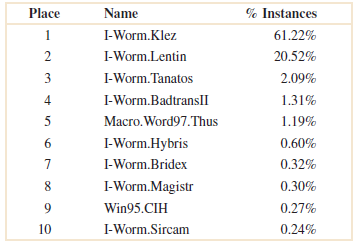An article in Information Security Technical Report [Malicious SoftwarePast, Present and Future (2004, Vol. 9, pp. 618)]
Question:
The 10 most widespread malicious programs for 2002

Suppose that 20 malicious software instances are reported.
Assume that the malicious sources can be assumed to be independent.
(a) What is the probability that at least one instance is €œKlez?€
(b) What is the probability that three or more instances are €œKlez?€
(c) What are the mean and standard deviation of the number of €œKlez€ instances among the 20 reported?
Fantastic news! We've Found the answer you've been seeking!
Step by Step Answer:
Related Book For 

Applied Statistics And Probability For Engineers
ISBN: 9781118539712
6th Edition
Authors: Douglas C. Montgomery, George C. Runger
Question Posted:





